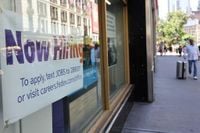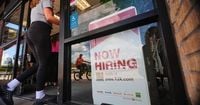Private sector hiring in the United States slowed sharply in August 2025, providing fresh evidence that the labor market’s momentum has faltered and raising the stakes for policymakers, businesses, and workers alike. According to data released Thursday morning by ADP, private employers added just 54,000 jobs during the month—well below the 75,000 positions forecast by economists polled by The Wall Street Journal and Dow Jones. The figure also represents a significant drop from July’s revised gain of 106,000 jobs, as reported by CNBC.
The disappointing numbers come as the nation’s job market faces mounting uncertainty. "The year started with strong job growth, but that momentum has been whipsawed by uncertainty. A variety of things could explain the hiring slowdown, including labor shortages, skittish consumers, and AI disruptions," said Nela Richardson, ADP’s chief economist, in a statement cited by Nexstar Media and CNBC. Richardson’s comments underscore the complex mix of factors—ranging from technological change to shifting consumer sentiment—that are weighing on employers’ willingness to take on new workers.
The details of the ADP report reveal a patchwork of strength and weakness across sectors. Leisure and hospitality stood out as a bright spot, contributing 50,000 new jobs in August. Construction followed with 16,000 new positions. However, these gains were offset by steep losses elsewhere: trade, transportation, and utilities shed 17,000 jobs, while education and health services declined by 12,000 roles. This uneven performance highlights the challenges facing industries still recovering from the disruptions of the past several years.
Wage growth, meanwhile, remained largely steady. Workers who stayed in their jobs saw their pay rise by 4.4% year-over-year, while those who changed jobs enjoyed a 7.1% increase, according to ADP’s data. While these figures suggest some resilience in workers’ bargaining power, they also reflect a labor market that is no longer running as hot as it was earlier in the year.
Thursday’s ADP report was released alongside fresh data from the Labor Department on unemployment claims, which rose by 8,000 to 237,000 for the week ending August 30, 2025. Economists had expected just 231,000 new applications, according to Nexstar Media. The uptick in jobless claims adds to the sense that the labor market is cooling, a view reinforced by the Job Openings and Labor Turnover Survey, which registered one of its weakest readings for job openings in July since 2020, as reported by CNBC.
All eyes now turn to the Bureau of Labor Statistics (BLS), which is scheduled to release its official August jobs report on Friday, September 5. This report is especially anticipated because it will be the first since President Trump fired the head of the BLS, Erika McEntarfer, following July’s lackluster employment report. That report showed only 73,000 jobs added—far short of expectations—and included the largest two-month downward revision of job growth since 1968, marking May and June’s figures lower, according to CBS MoneyWatch.
President Trump’s decision to dismiss the BLS chief drew sharp criticism from economists and policymakers who accused him of politicizing what has traditionally been a nonpartisan, technical process. As CBS MoneyWatch reported, the move sparked concerns that the administration’s actions could undermine confidence in the reliability of U.S. economic data—a benchmark not just for Americans, but for the global economy. Gregory Daco, chief economist at EY-Parthenon, warned that further efforts by the administration to question the accuracy of monthly jobs data could "sow further doubt about its validity."
The broader context for these developments is a labor market that has clearly lost steam in recent months. From January to April 2025, average monthly payroll gains stood at 123,000—well above the level needed to keep the unemployment rate, now at 4.2%, from rising. But from May to July, that average plunged to just 35,000, according to CBS MoneyWatch. For the first time since April 2021, the number of unemployed Americans (7.24 million) now exceeds the number of job openings (7.18 million), based on figures released Wednesday by the Labor Department.
"This is yet another data point underscoring how this job market is frozen, and it's difficult for anyone to get a job right now," Heather Long, chief economist at Navy Federal Credit Union, wrote in an email to CBS MoneyWatch. "This is a turning point for the labor market. It's yet another crack." The consensus among economists is that the August jobs report will be pivotal in determining whether the labor market is stabilizing or slipping further. FactSet forecasts suggest job gains could range from 40,000 to 80,000, with the unemployment rate expected to hold steady at 4.2%. However, there is widespread concern that July’s job growth could be revised down even further, signaling more sustained weakness than previously anticipated. Shruti Mishra, a U.S. economist at Bank of America Global Research, told CBS MoneyWatch, "Since every month in 2025 has been revised lower so far, the risk is that July job growth will also be marked down. This could point to more sustained labor market weakness than we have been forecasting."
The implications of these labor market trends extend far beyond the jobless figures. The Federal Reserve, which has spent much of the past two years battling inflation, is now expected to shift gears and cut its benchmark interest rate at its next policy meeting on September 16-17. The CME Group’s FedWatch tool puts the probability of a quarter-point rate cut at 95% to 97.4%, according to both CBS MoneyWatch and CNBC. Oxford Economics noted, "The report would have to be significantly stronger than we are forecasting to dissuade the [Fed] from cutting rates."
Looking ahead, many economists anticipate that payroll gains will average around 30,000 per month through the end of the year, with the nation’s jobless rate potentially rising to 4.7% by December. Gregory Daco summed up the prevailing sentiment in a research note reported by CBS MoneyWatch: "Looking ahead, the labor market slowdown is likely to persist."
For American workers, businesses, and policymakers, the coming weeks will be critical in charting a course through this period of economic uncertainty. The August jobs report, due Friday, will offer the clearest signal yet of whether the labor market is merely pausing for breath—or entering a more troubling phase of sustained weakness.






